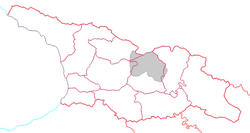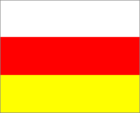South Ossetia
|
|
The Republic of South Ossetia (Ossetian: Республикæ Хуссар Ирыстон, Respublikae Xussar Iryston; Russian: Республика Южная Осетия, Respublika Yuzhnaya Osetiya; Georgian: სამხრეთი ოსეთია, Samkhreti Osetia) is a de facto independent republic within Georgia. Although it has declared its independence, its separation from Georgia has not been recognized by any other country. Georgia itself refuses to recognise South Ossetia as a distinct entity; the government calls it by the ancient name of Samachablo or, more recently, Tskhinvali region (after the republic's capital). South Ossetia is formally part of the Georgian region of Shida Kartli.
| |||||

| |||||
| Official language | Ossetian | ||||
| Capital | Tskhinvali | ||||
| President | Eduard Djabeevich Kokoity | ||||
| Prime Minister | Igor Viktorovich Sanakoyev | ||||
| Area – Total – % water | 3,900 km² n/a | ||||
| Population – Total – Density | (2004) 70,000 (approx) 18/km² | ||||
| Independence – Declared – Recognition | From Georgia – November 28, 1991 – none | ||||
| Currency | Russian ruble, Georgian lari | ||||
| Time zone | UTC +3 | ||||
| Contents |
Geography and economy
South Ossetia covers an area of about 3,900km² on the southern side of the Caucasus, separated by the mountains from the more populous North Ossetia (part of Russia) and extending southwards almost to the Mtkvari river in Georgia. It is extremely mountainous, with most of the region lying over 1,000m (3,300ft) above sea level. Its economy is primarily agricultural, although less than 10% of South Ossetia's land area is cultivated, with cereals, fruit and vines the major produce. Forestry and cattle industries are also maintained. A number of industrial facilities also exist, particularly around the capital Tskhinvali.
Following a war with Georgia in the 1990s, South Ossetia has struggled economically. Employment and supplies are scarce. Additionally, Georgia cut off supplies of electricity to the region, which forced the South Ossetian government to run an electric cable through North Ossetia. The majority of the population survives on subsistence farming. In addition to its economic problems, unclear political perspectives, thousands of refugees, and an illegal drug and arms trade have made the region unstable again in the last few years. Virtually the only significant economic asset that South Ossetia possesses is control of the Roki Tunnel that links Russia and Georgia, from which the South Ossetian government reportedly obtains as much as a third of its budget by the expedient of levying customs duties on freight traffic.
The Republic of South Ossetia is not a territorially contiguous entity. It is, instead, something of a checkerboard of Georgian-inhabited and Ossetian-inhabited towns and villages in an arc around the largely Ossetian city of Tskhinvali. The capital and most of the other Ossetian-inhabited communities are governed by the separatist government in Tskhinvali, while the Georgian-inhabited villages are governed by the Georgian government. This close proximity and the intermixing of the two communities has made the conflict in South Ossetia particularly dangerous, as any attempt to create an ethnically "pure" territory would necessarily have to involve population transfer on a large scale.
History
South-OssetiaMap.jpg
Medieval and early modern period
The Ossetians were originally descendants of Iranian-speaking tribes from Central Asia. They became Christians during the early Middle Ages, under Georgian influence. Under Mongol rule, they were pushed out of their medieval homeland south of the Don river in present-day Russia and part migrated towards and over the Caucasus mountains, to Georgia where they formed three distinct territorial entities. Digor in the west came under the influence of the neighboring Kabard people, who introduced Islam. Tualläg in the south became what is now South Ossetia, part of the historical Georgian pricipality of Samachablo, where Ossetians found refuge from Mongol invaders. Iron in the north became what is now North Ossetia, under Russian rule from 1767. Most Ossetians are now Russian Orthodox Christians, but there is also a significant Muslim minority.
South Ossetia under Russia and the Soviet Union
North and South Ossetia were annexed by Russia between 1801 and 1806, along with Georgia proper, and absorbed into the Russian Empire. Following the Russian Revolution, South Ossetia became a part of the Menshevik Georgian Democratic Republic, while the north became a part of the Terek Soviet Republic. In April 1922, following fierce fighting between White Russian and Soviet forces the "South Ossetian Autonomous Oblast" (i.e. district) was formed. Although South Ossetia had its own language (Ossetian), Russian and Georgian were administrative/state languages. At present, Russian is – the only administrative language used by the separatist government in Tskhinvali. In the Soviet time, under the rule of Georgia's government, it enjoyed some degree of autonomy, including to practice (Ossetian) language and teach it in schools.
The Georgian war
In 1989, concerned by rising nationalism in Georgia, the ruling South Ossetian Popular Front (Ademon Nykhas) demanded unification with North Ossetia. On 10 November 1989, the South Ossetian Supreme Soviet approved a decision to unite South Ossetia with the North Ossetian ASSR, part of Russia. A day later, the Georgian parliament revoked the decision and abolished South Ossetian autonomy. Additionally, the parliament authorized the suppression of newspapers and demonstrations.
Following Georgia's independence in 1991 under the nationalist leader Zviad Gamsakhurdia, the Georgian government declared Georgian to be the only administrative language throughout the country (Georgian was a state/administrative language throughout the soviet time along with Russian and it was written so both in the 1936 and 1979 constitutions of Georgian Soviet Socialists Republic). This caused great concern in South Ossetia, whose leaders demanded that Ossetian become the language of their state. The Ossetian minority continued to seek greater levels of autonomy, but were faced with increasing nationalist sentiment among the Georgian majority. Violent conflict broke out towards the end of 1991 during which many South Ossetian villages were attacked and burned down as well as Georgian houses and schools in Tskhinvali, the capital of South Ossetia. As a result, more than 100,000 refugees fled the region, most across the border into North Ossetia or into Georgia proper. Many South Ossetians were resettled in uninhabited areas of North Ossetia from which the Ingush had been expelled by Stalin in 1944, leading to conflicts between Ossetians and Ingush over the right of residence in former Ingush territory. Only 15% of the Ossetian population now lives in South Ossetia.
In 1992, Georgia was forced to accept a ceasefire to avoid a large scale confrontation with Russia. The government of Georgia and South Ossetian separatists reached an agreement to avoid the use of force against one another, and Georgia pledged not to impose sanctions against South Ossetia. A peacekeeping force of Ossetians, Russians and Georgians was established. From then, until mid-2004 South Ossetia was generally peaceful.
Recent history
Template:Politics of South Ossetia The political dispute has, however, yet to be resolved and the South Ossetian authorities still govern the region with effective independence from Tbilisi. Although talks have been held periodically between the two sides, little progress was made under the government of Eduard Shevardnadze (1993-2003). His replacement Mikhail Saakashvili (elected 2004) made the reassertion of Georgian government authority a political priority. Having successfully put an end to the de facto independent government of the southwestern province of Ajaria in May 2004, he pledged to seek a similar solution in South Ossetia.
By June, tensions between Tbilisi and Tshkinvali were beginning to rise. Georgian forces shut down a large market at Ergneti, which was a major trading point for tax-free goods from Russia. They also announced plans to set up a customs post on the South Ossetian section of the Russian border. In retaliation, South Ossetian forces closed the main highway between Russia and Georgia for several days.
In early June, three Georgian officers were detained by South Ossetian troops. In retaliation, Saakashvili refused to attend peace talks. Georgian soldiers then intercepted a Russian convoy carrying military equipment, including missiles, which led to tensions between Tbilisi and Moscow. More Georgian soldiers were then captured by Ossetian forces, though exactly how many is unknown, due to conflicting reports from each side. A peacekeeping force also came under fire, allegedly from local militia.
The situation continued to escalate into early-to-mid-July. Large numbers of Georgian and Ossetian police moved into the border areas, and there was frequent shooting for several days. The Georgian soldiers captured were all released, with three exceptions.
Tensions between Tbilisi and Moscow continued to worsen when the Russian Duma passed a resolution supporting South Ossetia. On July 12, Znaur Gassiev, the speaker of the South Ossetian parliament stated that the entity is "almost on a war footing". Alan Pliev, the foreign minister of South Ossetia, claimed that fellow unrecognized states Abkhazia and Transnistria were prepared to support South Ossetia if Georgia attacked. Additionally, the nationalities minister in the adjacent Russian province of North Ossetia stated that South Ossetia would "not remain without [their] help", if a conflict were to arise.
On July 15, after receiving pressure from the international community, which feared interruptions to the Baku-Tbilisi-Ceyhan Pipeline scheduled to come online at the end of the year, Georgia, Russia and South Ossetia all agreed to crisis talks in Moscow. The talks were somewhat successful, and a peace accord was signed the same day - although it applies only to the current crisis.
As of August, 2004, pro-Russian South Ossetian separatists continue to battle Georgian troops. A ceasefire deal reached on August 13 was repeatedly violated.
External links
- Fighting intensifies in S Ossetia (http://newsvote.bbc.co.uk/1/hi/world/europe/3579012.stm) (BBC news, 19 August, 2004)
- Special South Ossetia on Caucaz.com (http://www.caucaz.com/home_uk/pays.php?pays=6), Weekly Online about South Caucasus
- Photos and stories from South Ossetia (http://southosetia.euro.ru/)
- Ossetia—History, culture, politics, news (http://ossetia.ru) (in Russian)
See also
et:Lõuna-Osseetia eo:Sud-Osetio nl:Zuid-Ossetië os:Хуссар Ирыстон pl:Osetia Południowa pt:Ossétia do Sul ru:Южная Осетия sl:Južna Osetija sv:Sydossetien

